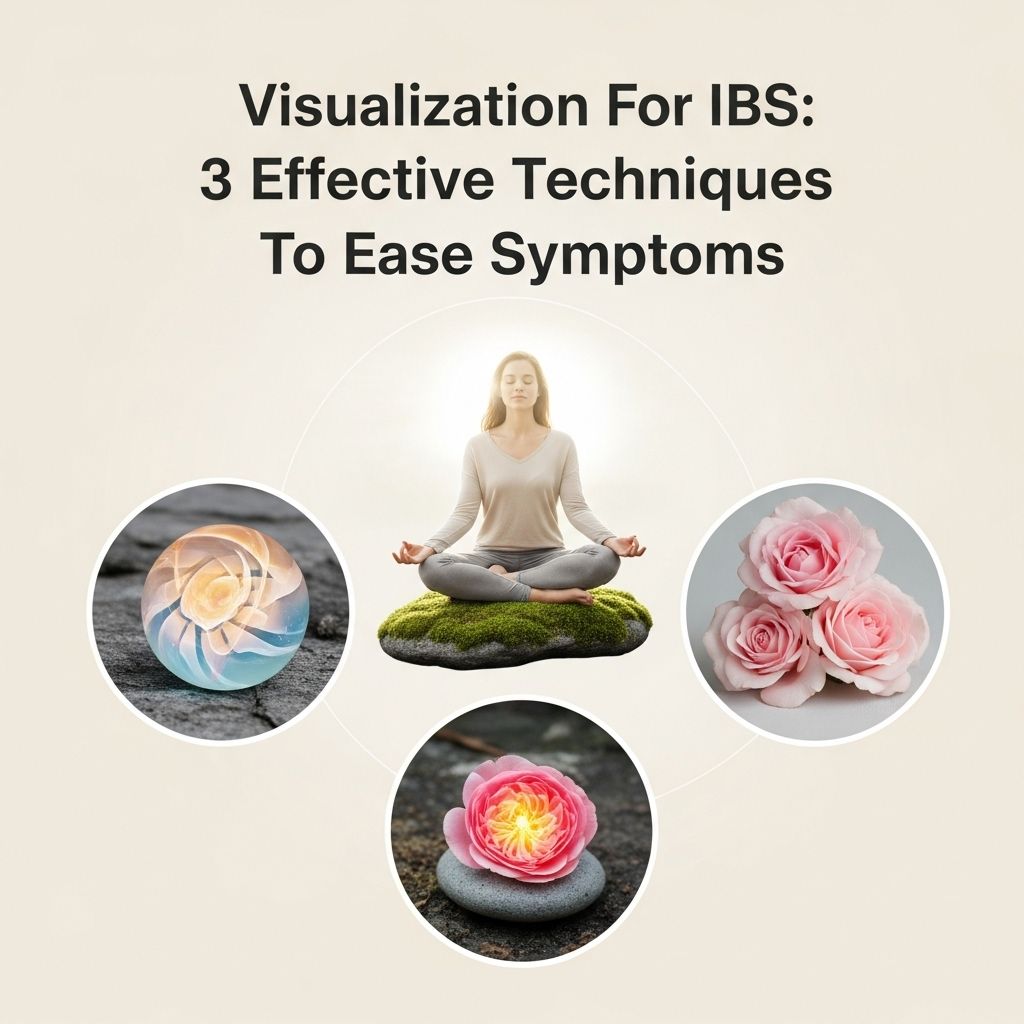Visualization for Irritable Bowel Syndrome (IBS): A Comprehensive Guide
Harness mental imagery to calm your gut and restore inner balance.

Introduction to Visualization for IBS
Visualization is a powerful tool used in managing symptoms of Irritable Bowel Syndrome (IBS), a common gastrointestinal disorder characterized by abdominal pain, bloating, and changes in bowel movements. By leveraging the mind-body connection, visualization can help reduce stress and promote relaxation, which are crucial in alleviating IBS symptoms.
Understanding IBS
IBS is a chronic condition often associated with stress, anxiety, and dietary factors. While its exact cause is unknown, managing stress through techniques like visualization can significantly improve symptoms.
How Visualization Works for IBS
Visualization involves using mental imagery to create a peaceful and relaxing environment, which helps distract from discomfort and reduce tension. This technique encourages the mind to focus on positive outcomes, such as improved digestion and reduced pain.
Key Visualization Techniques for IBS
- Guided Imagery: Imagine a peaceful scene, such as a beach or forest, to induce relaxation and reduce stress.
- Balloon Technique: Visualize pain as a balloon that shrinks as air is released, gradually becoming smaller until it disappears, symbolizing relief from discomfort.
- Body Scan: Focus on each part of the body, releasing tension and promoting relaxation.
Techniques for Effective Visualization
To practice visualization effectively, it’s important to create a conducive environment and maintain consistency.
Steps to Effective Visualization
- Find a Quiet Space: Choose a quiet, comfortable spot where you can relax without distractions.
- Relaxation: Close your eyes and take deep breaths to begin the relaxation process.
- Focus on Imagery: Visualize your chosen scene or object, engaging all senses to immerse yourself fully.
Examples of Visualization Exercises
Here are some examples of visualization exercises tailored for IBS:
Balloon Self-Hypnosis Technique
This technique involves imagining the pain as a balloon that changes color and size as it loses air, symbolizing relief from discomfort.
For example:
“Imagine your discomfort as a large [pain color] balloon. Watch this balloon get smaller and smaller as it slowly loses air. See the color of the balloon changing to a soft [preferred color], and feel your discomfort reducing as it becomes smaller until it disappears.”
Peaceful Scene Visualization
Imagine yourself in a serene environment, such as a beach or meadow, focusing on the sights, sounds, and sensations to create a sense of peace and relaxation.
Benefits of Visualization for IBS
Visualization offers several benefits for managing IBS symptoms:
- Reduces Stress: Since stress can exacerbate IBS symptoms, visualization helps in managing stress levels.
- Improves Mental Health: By promoting relaxation and reducing anxiety, visualization can enhance overall mental well-being.
- Enhances Body Awareness: Visualization techniques like body scanning can increase awareness of bodily sensations, helping to identify areas of tension.
Combining Visualization with Other Techniques
Visualization can be more effective when combined with other techniques such as deep breathing, meditation, and physical exercise.
Deep Breathing Exercises
Deep or abdominal breathing can be particularly helpful in relaxation and stress reduction:
- Abdominal Breathing: Focus on expanding your abdomen rather than your chest to promote deep relaxation.
- 4-7-8 Breathing: Breathe in for a count of 4, hold for 7, and exhale for 8, promoting calmness.
Challenges and Considerations
While visualization is a powerful tool, it may not be effective for everyone immediately. Consistency and patience are key.
Common Challenges
- Difficulty Relaxing: Some individuals may find it hard to relax initially, but with practice, it becomes easier.
- Distractions: Finding a quiet space can be challenging, but setting aside dedicated time helps.
- Consistency: Regular practice is essential to see lasting benefits.
Resources for Visualization
There are numerous resources available to help you practice visualization:
Guided Audio Sessions
Many apps and websites offer guided audio sessions specifically designed for relaxation and visualization.
Books and eBooks
There are several books that provide detailed guides on visualization techniques for managing stress and improving health.
Frequently Asked Questions (FAQs)
Q: What is the best time to practice visualization?
A: The best time is when you can relax without distractions, often just before bed or first thing in the morning.
Q: Can visualization completely cure IBS?
A: Visualization can help manage symptoms by reducing stress and promoting relaxation, but it is not a cure for IBS. It should be used alongside other treatments recommended by healthcare providers.
Q: How long does it take to see results from visualization?
A: Results can vary, but most people start to notice improvements in stress levels and symptom management within a few weeks of consistent practice.
Conclusion
Visualization is a valuable technique for managing IBS symptoms by promoting relaxation and reducing stress. By incorporating visualization into your routine, you can enhance your overall well-being and improve your quality of life.
References
- https://www.va.gov/WHOLEHEALTHLIBRARY/tools/balloon-self-hypnosis-technique-ibs-abdominal-pain.asp
- https://apps.nhslothian.scot/files/sites/2/IBS-FAP-PILs-3.pdf
- https://aboutibs.org/treatment/psychological-treatments/relaxation-techniques-for-ibs/
- https://www.ibshypnotherapy.nz/ibs-hypnosis-blog/tag/visualisation
- https://pmc.ncbi.nlm.nih.gov/articles/PMC9658118/
- https://www.youtube.com/watch?v=bQAAVa8LpYI
- https://badgut.org/information-centre/a-z-digestive-topics/brain-gut-connection-and-ibs/
Read full bio of Sneha Tete












